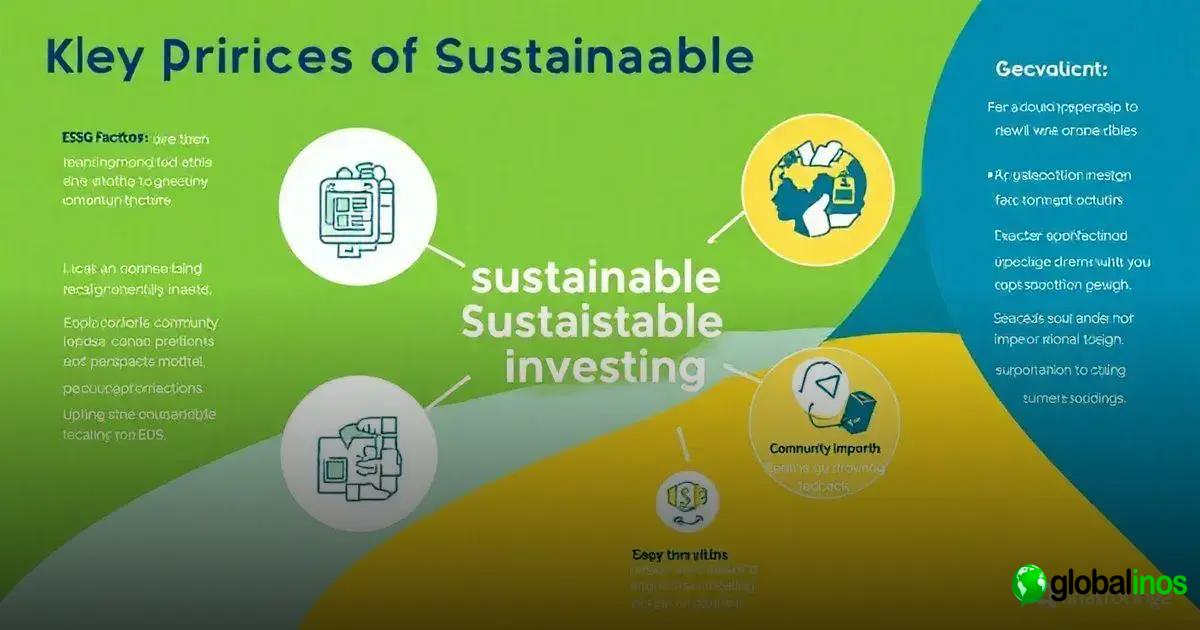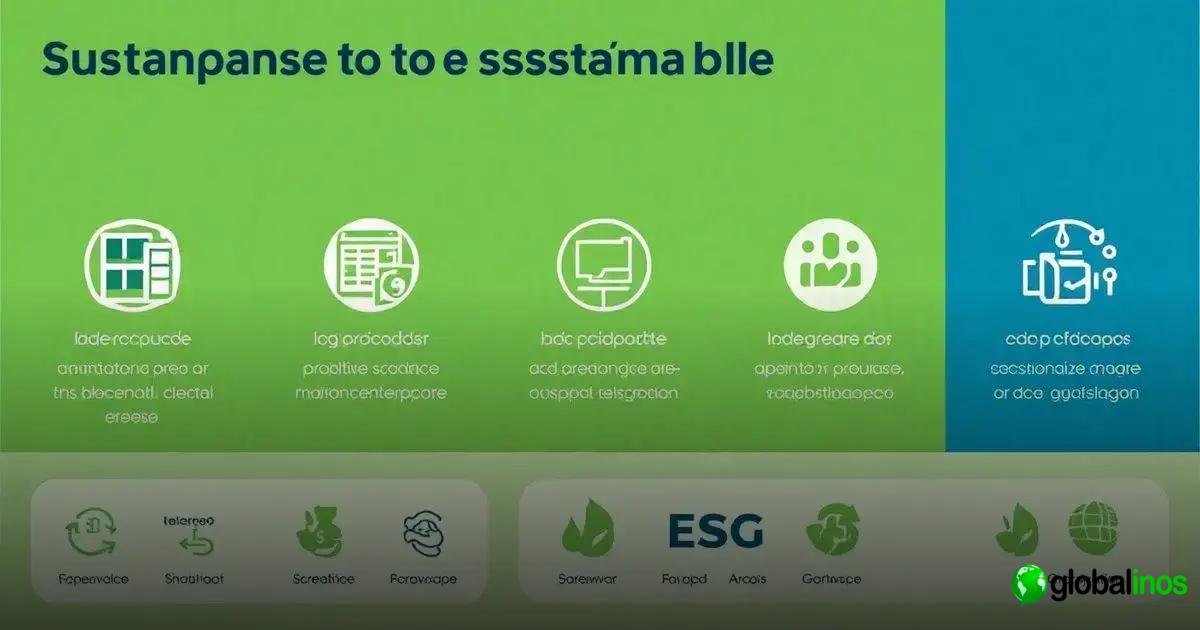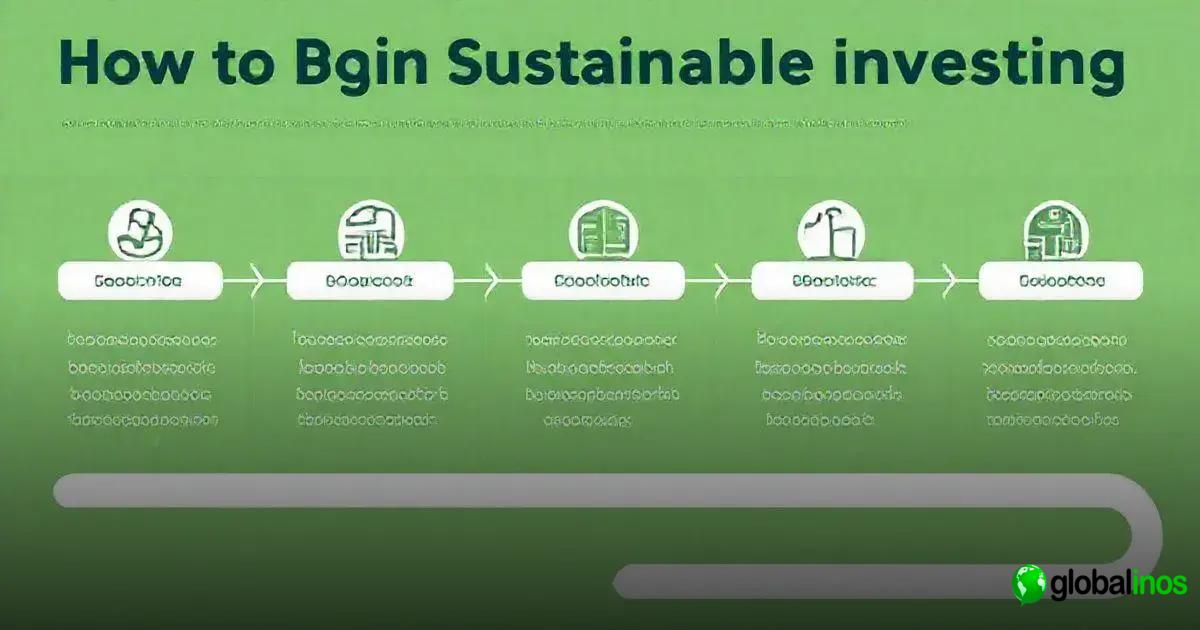Sustainable investing combines financial growth with positive social and environmental impact. It focuses on supporting companies that prioritize responsibility and ethical values. This approach allows you to invest with purpose.
By considering ESG factors, sustainable investments can reduce risks and support long-term stability. Companies with strong practices are often more resilient, offering reliable returns to their investors. It’s a smart choice for the future.
Curious to learn how sustainable investing can transform your portfolio and the world? Keep reading to discover its benefits and how to get started!
Understanding Sustainable Investing
Understanding sustainable investing is essential for investors today. This approach goes beyond traditional investing by incorporating environmental, social, and governance (ESG) factors into financial decisions. Sustainable investing is not just about making a profit; it’s about investing responsibly and considering the planet and society.
What is Sustainable Investing? It focuses on investments that generate positive social and environmental outcomes alongside financial returns. Investors are increasingly seeking opportunities that align with their personal values, leading to a demand for transparency and accountability from companies.
Key Components of Sustainable Investing
Sustainable investing typically involves three key components:
- Environmental Criteria: This considers how a company performs as a steward of nature, including its energy use, waste management, and conservation practices.
- Social Criteria: This evaluates how a company manages relationships with employees, suppliers, customers, and the communities where it operates.
- Governance Criteria: This focuses on a company’s leadership, executive pay, audits, internal controls, and shareholder rights.
The Importance of Research
Research plays a crucial role in understanding sustainable investing. Investors should look for data on ESG performance, ethical practices, and community engagement of companies they’re considering. Metrics can vary, so it’s important to choose reliable sources and ratings that align with investment goals.
Impact on Financial Performance
Research indicates that companies with strong ESG practices often demonstrate better financial performance. This is due to various factors, such as risk management, operational efficiency, and enhanced brand reputation. Therefore, understanding sustainable investing is not only beneficial for the planet but can also lead to better returns.
By grasping the essentials of sustainable investing, you will be prepared to make informed choices that reflect your values, enhance your portfolio’s potential, and contribute positively to society.
Key Principles of Sustainable Investing

Key Principles of Sustainable Investing serve as the foundation for making investment decisions that align with both profit and principles. Understanding these principles can enable investors to create a positive impact while pursuing financial returns.
1. Integration of ESG Factors
Sustainable investing emphasizes the integration of Environmental, Social, and Governance (ESG) factors into the investment process. This means evaluating companies not just on financial metrics but also on how they perform in areas that affect society and the environment.
2. Long-term Focus
Investors should adopt a long-term perspective, recognizing that sustainability issues may take time to materialize. This outlook encourages investment in companies that demonstrate resilience and a commitment to sustainable practices over time.
3. Active Ownership
Engaging with companies as an active owner is crucial. Investors can influence corporate behavior by voting on key issues, joining shareholder proposals, and fostering dialogue with management to advocate for responsible practices.
4. Transparency and Reporting
Sustainable investors prioritize transparency and demand accurate reporting from companies regarding their ESG efforts. Companies should provide clear, consistent data to allow investors to make informed decisions.
5. Screening and Selection
Investors often use screening methods to exclude companies that do not meet specific sustainability criteria. This could include avoiding industries such as fossil fuels or tobacco. Alternatively, investors may include companies with strong track records in sustainability.
6. Community and Social Impact
Sustainable investing considers the social impact of investments. This means supporting companies that positively influence the communities they operate in, contributing to social equity, and fostering economic development.
7. Risk Management
Understanding and managing risks related to sustainability issues is vital. Companies that ignore ESG factors may face operational, reputational, and regulatory risks. Sustainable investing seeks to mitigate these risks by selecting companies committed to responsible practices.
8. Portfolio Diversity
A diverse portfolio can enhance resilience in sustainable investing. Including a variety of sectors and asset classes ensures that risks are spread out and aligns with different sustainability criteria.
9. Mission-Driven Investing
Aligning investments with personal values is a core principle of sustainable investing. Many investors seek to create a lasting positive impact that reflects their beliefs about health, safety, and environmental stewardship.
Benefits of Sustainable Investing
Benefits of Sustainable Investing are vast and increasingly relevant in today’s world. By aligning investments with values that emphasize environmental and social responsibility, investors can achieve both financial and ethical outcomes.
1. Positive Impact on Society
Sustainable investing allows individuals to support businesses that prioritize social responsibility. This fosters community development and encourages companies to improve their practices, benefiting society as a whole.
2. Environmental Conservation
Investing in sustainable companies contributes to environmental protection. These companies focus on minimizing their ecological footprint, promoting renewable energy, and implementing resource-saving practices.
3. Long-term Financial Returns
Research has shown that sustainable investments can yield competitive, or even superior, financial returns over the long term. Companies committed to sustainability are often better managed and more resilient to economic challenges.
4. Risk Mitigation
Investing in companies that prioritize ESG practices helps reduce the risk of exposure to regulatory penalties, operational disruptions, and reputational damage. Sustainable investing encourages transparency, enhancing risk management.
5. Enhanced Reputation
For investors, adopting a sustainable investment strategy can elevate their personal or organizational reputation. Being recognized as a socially responsible investor attracts like-minded individuals and businesses.
6. Alignment with Personal Values
Many investors want their money to reflect their personal beliefs. Sustainable investing allows them to support causes they care about, ensuring their investments align with their values.
7. Community Development
Sustainable investing often leads to investments in companies that create jobs, support local economies, and promote fair labor practices. This contributes to stronger, more resilient communities.
8. Innovation and Growth
Investing in sustainable companies encourages innovation. These businesses often develop new technology and solutions that address pressing social and environmental issues, contributing to growth in emerging markets.
9. Investor Engagement
As sustainable investors engage with companies on ESG issues, they promote accountability and transparency. This activism can lead to positive changes in corporate behavior, benefiting both investors and the broader society.
Different Approaches to Sustainable Investing

Different Approaches to Sustainable Investing provide investors with various paths to align their financial goals with their values. Understanding these approaches can help in selecting the method that best suits individual preferences.
1. Negative Screening
This approach involves excluding companies or sectors that do not meet specific ethical criteria. Common exclusions include industries like tobacco, firearms, and fossil fuels. Investors use negative screening to avoid funding businesses they consider harmful.
2. Positive Screening
Unlike negative screening, positive screening focuses on including companies with strong ESG performance. Investors seek out businesses leading in sustainability, such as those producing renewable energy or promoting gender equality in management.
3. Impact Investing
Impact investing aims to generate measurable social or environmental benefits alongside financial returns. This method involves investing directly in projects or companies that address global challenges like climate change, education, or healthcare.
4. ESG Integration
This approach incorporates ESG factors into the traditional financial analysis. Investors assess how environmental, social, and governance criteria affect a company’s risk and return profile. This leads to well-informed investment decisions that factor in sustainability.
5. Thematic Investing
Thematic investing focuses on specific trends or themes related to sustainability. Investors may concentrate on sectors like clean energy, water conservation, or sustainable agriculture, reflecting a commitment to issues they care about.
6. Shareholder Engagement
When investors take an active role as shareholders, they engage in dialogue with companies about their ESG practices. This can lead to meaningful changes in corporate behavior, aligning business operations with sustainability goals.
7. Sustainability-Linked Bonds
Sustainability-linked bonds offer a way for investors to support companies committed to improving their ESG performance. These bonds tie financial terms, such as interest rates, to sustainability targets, incentivizing companies to meet their goals.
8. Green Funds
Green funds are mutual funds or ETFs that invest specifically in environmentally responsible companies. These funds provide investors with a diversified portfolio while supporting sustainable practices.
9. Community Investing
Community investing focuses on directing capital to underserved communities. This approach supports local businesses and initiatives, promoting economic growth and inclusivity.
Common Myths About Sustainable Investing
Common Myths About Sustainable Investing often prevent investors from exploring this important option. Clearing up these myths can help more people engage in sustainable investing effectively.
1. Sustainable Investing Means Sacrificing Returns
One of the biggest myths is that investing sustainably leads to lower financial returns. Research shows that sustainable investments can perform on par with or even outperform traditional investments. Companies that focus on ESG factors often manage risks better, leading to better long-term growth.
2. Sustainable Investing is Only for Environmentalists
Many believe that sustainable investing appeals only to environmentalists. In reality, it includes a wide range of issues, like social justice and corporate governance. Investors of all backgrounds can find aspects of sustainable investing that resonate with their values.
3. All Sustainable Investments Are the Same
This myth suggests that all sustainable investments follow the same criteria. However, sustainable investing encompasses various approaches, such as negative screening, positive screening, and impact investing, allowing investors to customize their strategies.
4. Sustainable Investing is Complicated
Some think sustainable investing is too complex for average investors. While it does require thoughtful consideration, many tools and resources are available to guide investors. Simpler strategies can also be just as effective without overwhelming complexity.
5. You Can’t Trust Sustainable Investing Ratings
Another common myth is that ESG ratings are unreliable. While some variability exists in ratings among different agencies, many organizations provide comprehensive assessments based on standardized criteria, helping investors make informed decisions.
6. You Have to Be a Wealthy Investor
Many believe that sustainable investing requires large amounts of capital, but that’s not true. Numerous investment options, including ETFs and mutual funds, allow smaller investors to participate while diversifying their portfolios.
7. It’s Just a Fad
Some view sustainable investing as a passing trend. However, the increasing relevance of environmental and social issues in today’s world suggests that sustainable investing is here to stay. As more investors demand these strategies, it will likely become a permanent aspect of the market.
8. Sustainable Investing is Only About the Environment
While environmental factors are crucial, sustainable investing also considers social and governance issues. This holistic approach ensures that investors can support businesses that align with broader ethical values.
9. You Can’t Be a Passive Investor
Many assume that sustainable investing requires active management and constant involvement. However, there are options, such as sustainable index funds, which allow passive investors to support sustainable companies without daily oversight.
How to Start Sustainable Investing

How to Start Sustainable Investing is a process that can benefit both your finances and the planet. Follow these steps to begin your journey into sustainable investing.
1. Define Your Values
Your first step should be to clarify what sustainability means to you. Identify the social and environmental issues you care about. This will guide your investment choices and help you align your portfolio with your personal beliefs.
2. Educate Yourself
It’s important to understand the basics of sustainable investing. Research different approaches, such as negative screening, positive screening, or impact investing. Familiarizing yourself with these concepts will prepare you to make informed decisions.
3. Set Your Financial Goals
Determine what you want to achieve with your investments. Are you looking for long-term growth, income, or a mix of both? Setting clear financial goals will help you choose the right sustainable investment strategy.
4. Choose an Investment Strategy
Select a sustainable investment strategy that aligns with your values and financial goals. You could invest in sustainable mutual funds, ETFs, or individual stocks of companies with strong ESG practices.
5. Diversify Your Portfolio
Diversification is key to managing risk. Consider investing in various sectors that align with your sustainability goals. This can include clean energy, sustainable agriculture, or ethical technology.
6. Review Fund Managers
If you choose to invest in funds, research the fund managers. Look for those with a solid track record in sustainable investing and transparent practices. Check their criteria for selecting investments and their commitment to responsible practices.
7. Monitor Your Investments
Keep track of your investments and their performance. Regularly review how well they align with your values and goals. Be prepared to make adjustments as needed to stay aligned with your sustainability objectives.
8. Engage with Companies
If you hold shares in companies, consider engaging with them. Attend annual meetings, vote on shareholder proposals, and express your support for sustainable practices. Active ownership can lead to positive changes within the companies you invest in.
9. Stay Informed About Regulations
Keep an eye on regulations affecting sustainable investing. Changes in laws can impact companies’ ESG commitments and alter investment opportunities. Staying informed will help you navigate the evolving landscape.
Evaluating Sustainable Investment Opportunities
Evaluating Sustainable Investment Opportunities is essential to ensure that your investments align with your goals and values. Here are some important steps to guide you in the evaluation process.
1. Research Company Practices
Before investing, examine the company’s commitment to sustainability. Research their policies on environmental protection, labor practices, and community engagement. Understanding a company’s practices helps you determine if it aligns with your values.
2. Review ESG Ratings
Check third-party ESG ratings to assess a company’s performance in environmental, social, and governance areas. Ratings from reputable organizations can offer insights into how well a company handles sustainability issues and compares to its peers.
3. Analyze Financial Performance
Evaluate the company’s financial health and stability. Look at key metrics like revenue growth, profitability, and debt levels. A financially strong company is more likely to sustain its commitment to sustainability over the long term.
4. Assess Product and Service Impact
Consider the impact of a company’s products or services on the environment and society. Do they contribute positively to sustainability goals? Companies offering solutions that address real-world issues are often better investment choices.
5. Investigate Leadership and Governance
Analyze the company’s leadership and governance practices. Strong, diverse leadership can indicate a commitment to ethical practices and decision-making. Check if the company has an independent board and transparent governance structures.
6. Examine Stakeholder Engagement
Look into how the company engages with stakeholders, including employees, customers, and communities. Companies that seek feedback and actively work with stakeholders tend to have better sustainability practices and reputations.
7. Evaluate Reporting and Transparency
Review how transparent the company is about its sustainability efforts. Access their sustainability reports and look for consistent and measurable targets. A commitment to regular reporting indicates accountability and progress.
8. Consider Industry Trends
Analyze industry trends related to sustainability. Companies in industries adapting to sustainability demands are often better positioned for growth. Stay updated on regulatory changes and consumer preferences influencing your industry of interest.
9. Seek Professional Advice
If you’re unsure about evaluating investment opportunities, consider seeking advice from a financial advisor specializing in sustainable investing. They can guide you through the evaluation process and help you make informed choices.
The Future of Sustainable Investing

The Future of Sustainable Investing is bright and increasingly relevant as global awareness of environmental and social issues continues to grow. Here are some key trends and predictions for the future of this investment approach.
1. Increased Demand for Sustainable Products
As consumers become more environmentally conscious, the demand for sustainable products and services is rising. Companies that prioritize sustainability are likely to gain a competitive edge in the marketplace.
2. Regulatory Changes
Governments worldwide are implementing stricter regulations regarding sustainability and corporate responsibility. This trend will push more companies to adopt sustainable practices, creating more investment opportunities for sustainable investors.
3. Integration of Technology
Advancements in technology, such as artificial intelligence and big data, are helping companies track and improve their sustainability metrics. These tools will enable investors to assess ESG performance more effectively, leading to informed investment decisions.
4. Focus on Climate Change Solutions
Investments aimed at combating climate change will continue to grow. Industries focused on renewable energy, carbon capture, and sustainable agriculture will attract more interest from investors concerned about the environment.
5. Emphasis on Transparency
Transparency in corporate sustainability efforts will become increasingly important. Investors will demand clear reporting of ESG outcomes, ensuring that companies are held accountable for their commitments.
6. Collaboration and Partnerships
Collaborations between businesses, governments, and non-profits will be key in driving sustainable initiatives. These partnerships can lead to innovative solutions and investment opportunities in various sectors.
7. Growing Interest from Millennials and Gen Z
Younger generations are showing a greater interest in sustainable investing. As they inherit wealth and make financial decisions, they are likely to prioritize investments that align with their values, further driving the market.
8. Evolving Metrics for Success
As sustainable investing matures, so will the metrics used to measure success. Traditional financial indicators will be complemented by robust ESG metrics, allowing for a more holistic assessment of investments.
9. Increased Diversity in Sustainable Investment Offerings
The market will see a broader range of sustainable investment options, catering to diverse investor preferences. This could include more thematic funds focused on specific issues such as social justice or biodiversity.
Regulations Impacting Sustainable Investing
Regulations Impacting Sustainable Investing play a crucial role in shaping the landscape for investors and businesses alike. Understanding these regulations can help investors make informed decisions and promote sustainability.
1. Environmental Regulations
Governments around the world are introducing environmental regulations to combat climate change and promote sustainable practices. These laws often impose limits on emissions and require companies to adopt eco-friendly practices, influencing investment opportunities.
2. Reporting Standards
Many countries are implementing mandatory sustainability reporting standards. These requirements ensure that companies disclose their use of natural resources and their impact on the environment. Transparent reporting allows investors to make better decisions based on the ESG performance of companies.
3. ESG Disclosure Regulations
Various jurisdictions are introducing regulations that mandate ESG (Environmental, Social, and Governance) disclosures. For instance, the European Union’s Sustainable Finance Disclosure Regulation (SFDR) requires investment firms to disclose how sustainability risks are integrated into their decision-making processes.
4. Tax Incentives
Governments may offer tax incentives for companies that adopt sustainable practices. These incentives encourage businesses to invest in sustainable technologies and operations, making them more attractive options for investors seeking to align their portfolios with sustainability goals.
5. Green Bonds Regulations
The market for green bonds is growing, and regulations governing these financial instruments are evolving. Many countries are setting standards for what qualifies as a green project, ensuring that proceeds from green bonds are used for genuine sustainability initiatives.
6. Guidelines for Responsible Investment
Regulatory bodies are developing guidelines for responsible investment practices. These guidelines help investors understand how to incorporate ESG criteria into their investment strategies and contribute to sustainable development.
7. International Agreements
International agreements on climate change and sustainability, such as the Paris Agreement, impact sustainable investing. These agreements create a framework for countries to set targets, which in turn influences corporate behavior and investment trends.
8. Shareholder Rights Regulations
Some regulations enhance shareholder rights to hold companies accountable for their ESG performance. Investors can vote on sustainability-related proposals, influencing corporate governance and practices.
9. Anti-Greenwashing Regulations
To combat greenwashing, regulations are being introduced to ensure that companies provide accurate information about their sustainability practices. These regulations protect investors from misleading claims and promote genuine sustainability efforts.
In summary, the future of sustainable investing is bright
Sustainable investing offers a pathway to align financial goals with ethical values, addressing pressing global challenges such as climate change and social inequality.
With increasing demand for transparency, regulations shaping the landscape, and numerous approaches to incorporate ESG principles, investors are better equipped than ever to make informed decisions.
As awareness continues to grow, so does the potential for sustainable investments to yield positive financial returns while contributing to a healthier planet.
Ultimately, by embracing sustainable investing, individuals and institutions can play a critical role in building a more sustainable future for all.





